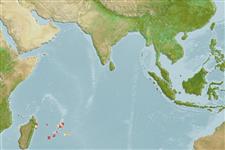Klassifizierung / Names
Namen | Synonyme | Catalog of Fishes(Gattung, Arten) | ITIS | CoL | WoRMS | Cloffa
>
Blenniiformes (Blennies) >
Blenniidae (Combtooth blennies) > Salariinae
Etymology: Cirripectes: Latin, cirrus = curl fringe + Greek, pektos, -e, -on = made of several parts solidly united (Ref. 45335); randalli: Named for Dr. J. E. Randall..
Environment: milieu / climate zone / depth range / distribution range
Ökologie
seewasser demersal; tiefenbereich 0 - 8 m (Ref. 529). Tropical; 15°S - 23°S
Western Indian Ocean: known only from Mauritius and Cargados Carajos Shoals. Recently reported from Reunion (Ref. 53568).
Length at first maturity / Size / Gewicht / Alter
Maturity: Lm ?, range 9 - ? cm
Max length : 10.7 cm SL Männchen/unbestimmt; (Ref. 529)
Rückenflossenstacheln (insgesamt): 12; Rückenflossenweichstrahlen (insgesamt): 14-15; Afterflossenstacheln 2; Afterflossenweichstrahlen: 15 - 16; Wirbelzahl: 30. Diagnosis: Dorsal fin XII, 14, membrane attached to caudal fin, with deep notch above last spine, first spine about equal to second; anal fin II, 16; pectoral rays 15; pelvic fin I, 4; caudal fin procurrent rays 10-12. Vertebrae 10 + 20. Last epipleural rib modally on vertebral centrum 19. LL, without scales and scalelike flaps; LL tubes 1-7, canal ends on caudal-fin base. Lower lip smooth mesially, plicate laterally. Upper lip crenulae 36-43. Gill rakers 26-27. Cephalic sensory pore system complex, no pores at the extra interorbital position. Midsnout pores present. Cirri, supraorbital 12-26, nasal 10-18; nuchal cirri 36-42, in 4 groups, ventralmost group borne on a slightly expanded flap. Body spots, extending to basal half of dorsal, anal and caudal fins in females but not in males (Ref. 529).
Facultative air-breathing in the genus (Ref. 126274); Adults occur on coral patches in surge channels of rocky reefs with light surf, 0-8 m deep (Ref. 529). Oviparous. Eggs are demersal and adhesive (Ref. 205), and are attached to the substrate via a filamentous, adhesive pad or pedestal (Ref. 94114). Larvae are planktonic, often found in shallow, coastal waters (Ref. 94114).
Oviparous, distinct pairing (Ref. 205). Urogenital orifice of male genital papilla located basally between 2 widely separated slender filaments on a fleshy swelling behind anus; testes bulbous with length equal its width (Ref. 205).
Williams, J.T., 1988. Revision and phylogenetic relationships of the blenniid fish genus Cirripectes. Indo-Pac. Fish. (17):78 p. (Ref. 529)
IUCN Rote Liste Status (Ref. 130435)
Bedrohung für Menschen
Harmless
Nutzung durch Menschen
Fischereien: nicht kommerziell
Mehr Information
ReferenzenAquakulturAquakultur ProfilZuchtlinienGenetikElectrophoresesVererbbarkeitKrankheitenVerarbeitungNutrientsMass conversion
PartnerBilderStamps, Coins Misc.LauteCiguateraGeschwindigkeitSchwimmstilKiemenoberflächeOtolithsGehirngrößeSehfähigkeit
Tools
Zusatzinformationen
Download XML
Internet Quellen
Estimates based on models
Preferred temperature (Ref.
123201): 25.4 - 26.8, mean 26.2 °C (based on 28 cells).
Phylogenetic diversity index (Ref.
82804): PD
50 = 0.5000 [Uniqueness, from 0.5 = low to 2.0 = high].
Bayesian length-weight: a=0.01072 (0.00480 - 0.02393), b=3.01 (2.82 - 3.20), in cm total length, based on LWR estimates for this (Sub)family-body shape (Ref.
93245).
Trophic level (Ref.
69278): 2.0 ±0.00 se; based on food items.
Widerstandsfähigkeit (Ref.
120179): hoch, Verdopplung der Population dauert weniger als 15 Monate. (Preliminary K or Fecundity.).
Fishing Vulnerability (Ref.
59153): Low vulnerability (10 of 100).
